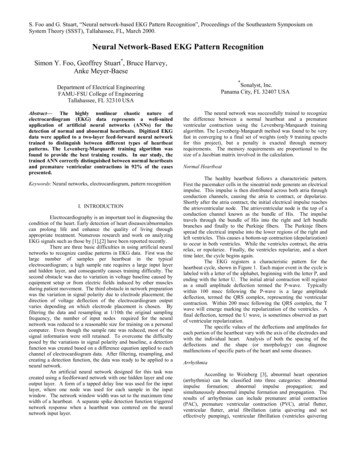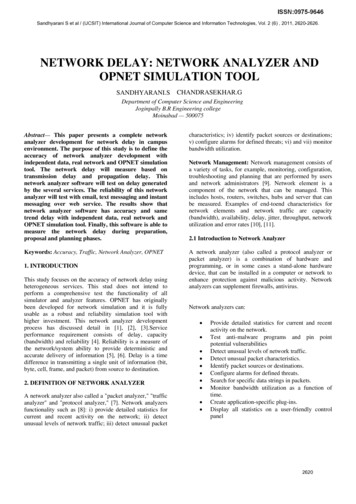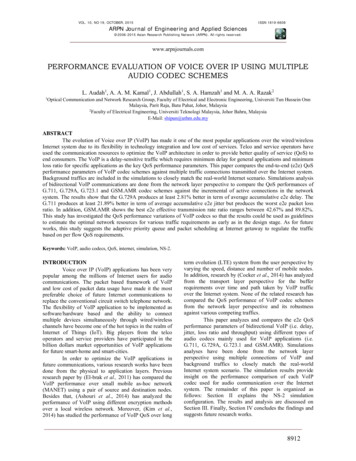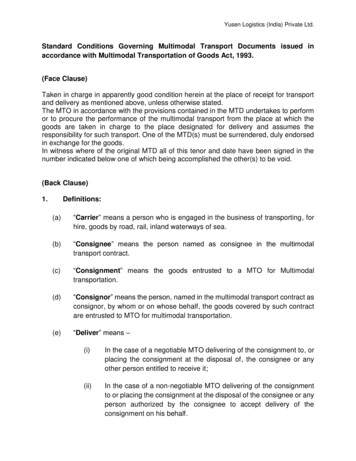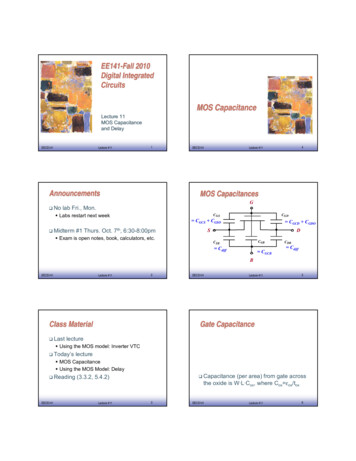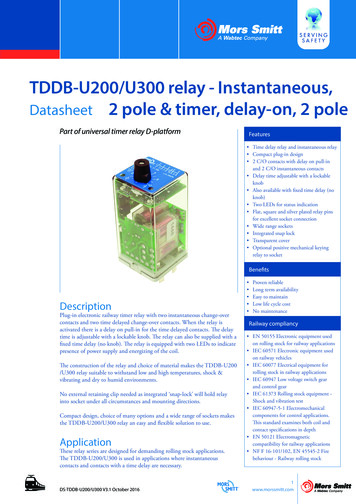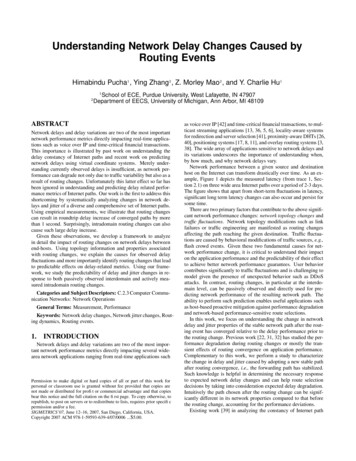
Transcription
Understanding Network Delay Changes Caused byRouting EventsHimabindu Pucha1 , Ying Zhang2 , Z. Morley Mao2 , and Y. Charlie Hu112School of ECE, Purdue University, West Lafayette, IN 47907Department of EECS, University of Michigan, Ann Arbor, MI 48109ABSTRACTNetwork delays and delay variations are two of the most importantnetwork performance metrics directly impacting real-time applications such as voice over IP and time-critical financial transactions.This importance is illustrated by past work on understanding thedelay constancy of Internet paths and recent work on predictingnetwork delays using virtual coordinate systems. Merely understanding currently observed delays is insufficient, as network performance can degrade not only due to traffic variability but also as aresult of routing changes. Unfortunately this latter effect so far hasbeen ignored in understanding and predicting delay related performance metrics of Internet paths. Our work is the first to address thisshortcoming by systematically analyzing changes in network delays and jitter of a diverse and comprehensive set of Internet paths.Using empirical measurements, we illustrate that routing changescan result in roundtrip delay increase of converged paths by morethan 1 second. Surprisingly, intradomain routing changes can alsocause such large delay increase.Given these observations, we develop a framework to analyzein detail the impact of routing changes on network delays betweenend-hosts. Using topology information and properties associatedwith routing changes, we explain the causes for observed delayfluctuations and more importantly identify routing changes that leadto predictable effects on delay-related metrics. Using our framework, we study the predictability of delay and jitter changes in response to both passively observed interdomain and actively measured intradomain routing changes.Categories and Subject Descriptors: C.2.3 Computer Communication Networks: Network OperationsGeneral Terms: Measurement, PerformanceKeywords: Network delay changes, Network jitter changes, Routing dynamics, Routing events.1.INTRODUCTIONNetwork delays and delay variations are two of the most important network performance metrics directly impacting several widearea network applications ranging from real-time applications suchPermission to make digital or hard copies of all or part of this work forpersonal or classroom use is granted without fee provided that copies arenot made or distributed for profit or commercial advantage and that copiesbear this notice and the full citation on the first page. To copy otherwise, torepublish, to post on servers or to redistribute to lists, requires prior specificpermission and/or a fee.SIGMETRICS’07, June 12–16, 2007, San Diego, California, USA.Copyright 2007 ACM 978-1-59593-639-4/07/0006 . 5.00.as voice over IP [42] and time-critical financial transactions, to multicast streaming applications [13, 36, 5, 6], locality-aware systemsfor redirection and server selection [41], proximity-aware DHTs [26,40], positioning systems [17, 8, 11], and overlay routing systems [3,38]. The wide array of applications sensitive to network delays andits variations underscores the importance of understanding when,by how much, and why network delays vary.Network performance between a given source and destinationhost on the Internet can transform drastically over time. As an example, Figure 1 depicts the measured latency (from trace 1, Section 2.1) on three wide area Internet paths over a period of 2-3 days.The figure shows that apart from short-term fluctuations in latency,significant long term latency changes can also occur and persist forsome time.There are two primary factors that contribute to the above significant network performance changes: network topology changes andtraffic fluctuations. Network topology modifications such as linkfailures or traffic engineering are manifested as routing changesaffecting the path reaching the given destination. Traffic fluctuations are caused by behavioral modifications of traffic sources, e.g.,flash crowd events. Given these two fundamental causes for network performance change, it is critical to understand their impacton the application performance and the predictability of their effectto achieve better network performance guarantees. User behaviorcontributes significantly to traffic fluctuations and is challenging tomodel given the presence of unexpected behavior such as DDoSattacks. In contrast, routing changes, in particular at the interdomain level, can be passively observed and directly used for predicting network performance of the resulting network path. Theability to perform such prediction enables useful applications suchas host-based proactive mitigation against performance degradationand network-based performance-sensitive route selections.In this work, we focus on understanding the change in networkdelay and jitter properties of the stable network path after the routing event has converged relative to the delay performance prior tothe routing change. Previous work [22, 31, 32] has studied the performance degradation during routing changes or mostly the transient effects of routing convergence on application performance.Complementary to this work, we perform a study to characterizethe change in delay and jitter caused by adopting a new stable pathafter routing convergence, i.e., the forwarding path has stabilized.Such knowledge is helpful in determining the necessary responseto expected network delay changes and can help route selectiondecisions by taking into consideration expected delay degradation.Intuitively the path chosen after the routing change can be significantly different in its network properties compared to that beforethe routing change, accounting for the performance deviations.Existing work [39] in analyzing the constancy of Internet path
planet3.berkeley.intel-research.net -- planetlab1.cs.uoi.grplanetlab-4.cs.princeton.edu -- T (ms)220300RTT (ms)RTT ley.intel-research.net -- 0100400000450000Time (seconds)500000550000600000550000Time (seconds)600000650000700000750000800000Time (seconds)Figure 1: Network delay changes over time for sample source-destination pairs.properties and predicting network delays based on virtual coordinate systems [18, 9] has so far ignored the effect of routing changeson network performance. However, routing changes are inevitabledue to the continuous state of flux of the entire Internet caused byphysical and configuration modifications. In this work, we addressthis shortcoming by systematically examining a comprehensive setof routing events occurring across diverse network locations andtheir effect on delay-related metrics of the communication betweena given source and destination host.Our work is also motivated by recent research proposals on revealing path diversity through protocol changes [33, 34] or newrouting services [15, 10] and commercial products [7, 1] on edgebased load balancing for multihomed networks. Given the inherentpath diversity [30] on the Internet, our work provides guidelinesfor path selection taking into consideration the impact on delay behavior. Recent work [27] on understanding Internet path inflationfocused on identifying delay increase caused by topology and routing policies. Between a given source and destination node, thereusually exists multiple paths depending on the state of the network.Our work helps identify the delay difference across such paths.We summarize our key experimental findings here. We identifiedthat more than 40% of paths studied experience delay changes ofmore than 50ms, confirming the conjecture that network delays ofInternet paths are subject to fluctuations caused by routing changes.Further analysis shows that the variability of delay changes is actually small for most path transitions measured, allowing applicationsto make use of such stability. Thus, we analyze the predictabilityof network delay and jitter changes caused by routing events andidentify network and route properties that lead to predictable delayand jitter fluctuations. Routing changes restricted to within a single network are expected to have minimal impact on network delaychanges due to limited size of a single network and typically richconnectivity within large networks. Thus, we find to our surprisethat intradomain routing change caused by certain networks can account for significant delay increase, sometimes up to 1 second, dueto sparse internal network connectivity. The degree of similaritybetween the newly advertised path and the current path provides anindication of the expected delay changes. We also identify a fewASes responsible for a large number of delay increases followingpath changes.The main contributions of our paper are the following: We demonstrate the significant impact of routing changes onnetwork delay and jitter at the Internet path level, focusing onstable paths before and after routing changes. This is the firstcomprehensive study on the effect of routing events on endto-end network delay behavior after routing convergence. We examine the network properties of routing changes toidentify causes for delay changes. By identifying dominantAS hop contributing to most delay changes, we account fordelay variations caused by queueing delays due to persistentcongestion as well as increased propagation delays. We alsonote a few ASes involved in many path changes contributingto significant latency and jitter variations. We analyze at a fine-grained level the stability of path latencyand jitter as well as the predictability of changes in delayand jitter due to routing events. We identify network androute properties to help predict delay degradation caused byrouting changes. Additionally, we develop a new measurement and analysismethodology for studying the effects of routing changes onlatencies of converged network paths, enabling a more comprehensive study of the delay constancy property of Internetpaths.The paper is organized as follows. Section 2 describes our experimental methodology for data collection and analysis. Section 3summarizes high-level observations of routing changes: their extent and impact on network delay changes. Section 4 then performsmacroanalysis of the observations by separating interdomain fromintradomain path changes. Section 5 further performs microanalysis by studying the network properties of routing changes to identify causes for delay changes. Section 6 summarizes the findingsand their impact on latency predictability as well as application performance. Finally, Section 7 discusses related work and Section 8draws conclusions.2. EXPERIMENT METHODOLOGYTo effectively capture the impact of routing events on networkdelays of Internet paths after convergence, we need to constructa monitoring system to record the delay values of converged network paths and the network route information to identify routingchanges. Our goal is to achieve sufficiently representative coverageof the Internet by selecting a wide range of network paths withoutincurring significant measurement overhead. Routing changes atthe interdomain level can be passively identified using a monitoring BGP session with the local BGP router, which is easily set up.However, this does not capture intradomain routing changes thatmay not be visible in BGP. Passively identifying routing changesinternal to an AS (Autonomous System or network) requires access to intradomain routing protocol data such as OSPF and IS-IS,making it infeasible to obtain such information from all networks ofinterest. Therefore, tracking fine-grained IP-level routing changesrequires continuous monitoring using active probing. We developed two complementary approaches in collecting data, balancingthe trade-off between overhead and coverage as well as data granularity.
2.1 Data sets2.2 JustificationsWe discuss limitations with our two experimental setups andTrace 1100% of src-dst pairsTrace 1: In the first setup, we perform continuous monitoring of60,000 Internet paths from 200 vantage points to 300 destinationhosts. Both the vantage points and destination hosts are chosenfrom the PlanetLab testbed [23] to achieve both geographic andnetwork diversity. Vantage points and destination hosts are fromunique PlanetLab sites and have significant overlap. These IPscover 258 distinct /24 network prefixes and 186 distinct origin Autonomous Systems or ASes. The NANOG traceroute tool is used toperform traceroute approximately every 20 minutes to each of thedestination host from each source node, using a time-out value of4 seconds per traceroute run and three probes for each router hop.Network roundtrip delay or RTT values are directly obtained fromtraceroute results. ICMP-based delay measurements are quite accurate, as Govindan and Paxson have shown that ICMP generationtimes are negligible for estimating RTT values [12]. RTT valuescapture both the forward and reverse delays and are used to analyze the impact of routing changes of the forwarding path on theone-way network delay. We later discuss the implication of thisapproximation and verify the effect of reverse path delay changes.The data collection using this active probing based setup lasted 20days in October 2006 and we term this first data set Trace 1 in subsequent discussions.Trace 2: In the second experiment setup, active probing is triggered from passively monitored real-time local BGP routing updates at five network locations of the RON testbed [25]. Thesefive hosts with four distinct upstream providers respectively resideat Global Crossing network in Chicago, MIT, an edge network inSeattle, Global Crossing network in New York, and University ofMichigan. Each BGP update indicates that the local route to a givendestination prefix has changed from BGP’s perspective. As soon asan update is received, one traceroute run is executed to an identifiedlive IP of the prefix. Traceroute is repeated as long as the consecutive IP level paths differ, indicating that convergence is still inprogress. Ten ping probes are sent as soon as the path is convergedto obtain RTT values.Several precautions are undertaken to limit the probing frequencypreventing excessively probing a host or a network. We restrict themaximum continuous probe duration for each prefix to be within10 minutes as routing events usually converges within several minutes [14]. At most one probing process is permitted for each prefix,and the minimum probing interval for the same prefix is restrictedto 10 minutes.Live IPs responding to ICMP probes are needed to probe delaychanges. Combining active probing [35] with traffic logs such asDNS data, we collected live IPs covering 61% of all announced prefixes and 68% of all ASes on the Internet. We find the set coversa large percentage of ASes in different tiers of the Internet hierarchy. These live IPs cover 58% of all prefixes and 62% of ASes inrouting updates monitored during our study.The data set for which results are presented in this paper was collected for 12 days starting from October 19th and termed as Trace2. RTT of the stable path is measured by taking the average of 10ping responses. We treat two paths as different if any of the IP hopsdiffer. If the number of missing hops is above 5, the path is notassumed to have converged.In summary, both measurement approaches are complementaryby providing a comprehensive view of how both interdomain andintradomain routing events influence end-to-end delay and jitter between a source and a destination host.80604020000.20.40.6Similarity coefficient0.81Figure 2: Distribution of similarity coefficient for all node-pairs.argue why they do not affect our analysis. First, classic traceroute tools are susceptible to loop, cycle, and diamond problems [4]caused by load balancing routers. In Trace 1, we purposely ignorepaths containing obvious anomalies such as loops and cycles, butmay still overestimate the number of unique paths. This limitation may cause us to associate RTT values of the same IP-levelpath with different paths; however, for the remaining true routing changes, our analysis of delay performance changes inducedby routing events is unaffected. As future work, we will use ParisTraceroute [4] to more accurately identify IP-level routing changes.We intentionally focus on delay behavior after routing is stabilized, thus traceroute measurements ideally should be made duringtime periods with stable routing. As each hop is probed three times,we can detect potential load-balancing or routing changes throughdisagreeing IP addresses returned for the three probes at each hop.In both traces, such paths are ignored to reduce the transient effectof routing changes.Throughout this paper, we use RTTs to capture the effect of arouting change from a source node to a destination node on thenetwork delay and jitter of the directed path. In the event that thereverse routing change is not correlated with the forward change,the change in RTT reflects the contribution from the forward pathchange alone. However, if a reverse routing change coincides withthe forward change and is in fact a result of the forward changeor vice-versa, the change in RTT captures the effect of both theseevents. Note that most applications tend to care about round-tripdelays instead of just purely one-way delays due to bidirectionalcommunication. Thus, understanding how routing changes on theforward path can influence RTT is important for delay or jitter sensitive applications.To understand the likelihood of forward and reverse changes coinciding, we examine Trace 1 which consists of a large amountof symmetrical probes. We first quantify the amount of sharing between two AS-level paths (the forward and reverse path in this case)by defining a similarity coefficient γ between two paths Pi and Pj .Given that the set of ASes in Pi and Pj are A and B respectively,γPi ,Pj is calculated asγPi ,Pj A B A B Figure 2 shows that the amount of sharing at AS-level between theforward and reverse path in Trace 1. It shows that 35% of the pathshave similarity coefficients larger than 0.8. Hence reverse pathchanges can be potentially correlated with forward path changes.The analysis of Trace 2 is unlikely to be affected by the inac-
planet3.berkeley.intel-research.net -- .edu -- T (ms)RTT 0200250000planet3.berkeley.intel-research.net -- csplanetlab1.kaist.ac.krRTT 0Time (seconds)500000550000600000550000600000Time (seconds)650000700000750000800000Time (seconds)Figure 3: Network delay changes over time annotated with routing changes for sample source-destination pairs.Trace 1100% of src-dst pairscuracy introduced by delay changes on the reverse paths. This ismainly due to the fact that most routes in commercial Internet tendto be asymmetric; thus, routing changes on the forward paths donot usually correlate with those on the reverse paths. Unlike Trace1, Trace 2 consists mainly of paths traversing the commercial Internet. In addition, analysis of Trace 2 is further unlikely to be affectedby the reverse path changes as the networks associated with sourcenodes in Trace 2 are well connected and have good routing stability as verified by examining updates associated with these prefixesfrom RouteViews BGP data [19].806040200HIGH-LEVEL OBSERVATIONS OF PATHCHANGESIn this section, we show that (1) Path latency changes happen, (2)When they do happen, they can be significant enough that applications need to care about them, and (3) The underlying availabilityof multiple network level paths is one cause of latency changes.Consider the latency fluctuations shown in Figure 1. We identified the different network-level paths associated with the threesource destination pairs in the figure and correlated them with thelatency changes. The annotated latency changes with the routesused are shown in Figure 3. The figure clearly shows that routingchanges can cause large increases in latency and such changes canpersist. For example, on the path planet3.berkeley.intel-research.net planetlab1.cs.uoi.gr when route R1 changed to route R3 the latency increased by 60% and then remained high for 8184 secondsbefore again reducing by 60% when R3 changed back to R1. Similarly, the latency on the path from planetlab-4.cs.princeton.edu planetlab2.cs-ipv6.lancs.ac.uk increased by around 20ms andstayed high for days when the IP level route changed from R1 toR2.Given that routing changes caused latency changes in the samplescenarios described above, we are interested in knowing the biggerpicture of how often routing changes occur. Figure 4 answers thisquestion by depicting the distribution of the fraction of times routing changes were observed when monitoring a source-destinationpair. In fact, Figure 4 shows that for 60% of source-destinationpairs in Trace 1, one single routing change was observed every 100times the source-destination path was consecutively probed whilefor 20% of source-destination pairs 10 routing changes were observed for every 100 probes!While this is a significant rate of change, it is possible that therouting change doesn’t really matter, i.e. it did not have any discernible impact on the network delay properties. To ascertain thisaspect, we also extracted the distributions of maximum latency differences observed in our measurements from Trace 1. The resultsin Figure 5 show that the routing changes do cause network delayproperties to change. We observe that 50% of source-destinationpairs had a maximum latency change of more than 30ms while00.10.20.30.40.50.60.7Number of path transitions / Total samples0.8Figure 4: Fraction of path transitions per source-destination pair.Trace 1100% of src-dst pairs3.8060402000100200300400Maximum latency difference (ms)500Figure 5: Distribution of maximum difference between median latency when IP paths switch per source-destination pair.30% of the source-destination pairs had a latency change of morethan 100ms whenever routing changes occurred. This gives anidea about the maximum impact possible on applications due tolatency fluctuations. We found that latency fluctuations can resultin a change of up to one second.In summary, routes change often result in significant changes tonetwork delay properties. Hence, we now study more closely thecharacteristics of routing changes and the impact of routing eventson latency changes.4. MACROANALYSIS: INTERDOMAIN VS.INTRADOMAIN ROUTING CHANGESIn this section, our goal is to understand the interplay betweenrouting changes and network delay and jitter properties. To thisend, we characterize routing events and the causal effect of routing
events on network delay and jitter properties by analyzing the twotraces. We focus on the difference in the impact of the two typesof possible routing changes: intradomain (within an AS) and interdomain (across ASes). This macroanalysis serves to answer howoften path changes occur, how long they last, and how network delay properties change due to routing events.4.1 How often do path changes occur?Before correlating path events with their impact on the networkdelay and jitter properties, we first characterize the extent of pathchanges for the 60,000 paths proactively monitored for 20 days inTrace 1 and the live IPs covering 61% of all announced prefixes onthe Internet reactively monitored for 12 days in Trace 2.Figure 6 provides information on how fast routing changes areobserved in both traces for both interdomain and intradomain changes.Essentially it plots a distribution of the fraction of times a routing change is observed while continuously monitoring the path between a source-destination pair. The first figure shows that for 60%of source-destination pairs, at least one intradomain routing changeis observed every time the path is sampled 100 times consecutively.Additionally, 20% of source-destination pairs see an even higherrate of intradomain routing changes ranging from 10 every 100samples to 70 every 100 samples. We also observe that the interdomain routing changes occur less frequently, e.g., almost all sourcedestination pairs observe less than 10 changes every 100 samples.Thus, interdomain changes are far less frequent than intradomainchanges. While intradomain changes appear to occur frequently, itremains to see how many unique paths exist given these frequentrouting changes.Thus, the next logical step is to characterize the actual amount ofpath-diversity, i.e., the number of unique paths that a given sourcedestination path can potentially use. Figure 7 shows the CDF ofthe number of unique AS-level and IP-level paths seen by eachsource-destination pair, for Trace 1 and Trace 2. The results showthat for Trace 1, 50% of source-destination pairs witnessed 6 ormore unique IP paths, and 20% of source-destination pairs witnessed 12 or more unique IP paths, while only about 6% sourcedestination pairs did not experience any path changes. In addition,about 20% of source-destination pairs had more than three uniqueAS paths. Interestingly, around 12% of source-destination pairshad more than 20 unique IP-level paths. Most of these sourcedestination pairs had a large number of paths with small changeslikely due to load balancing etc. In addition, certain paths suchas those from an AT&T PlanetLab node to nodes in Germany andSwitzerland had a large number of unique paths to reach each otherand did in fact frequently switch between them.For Trace 2, Figure 7 shows that 50% of source-destination pairswitnessed 3 or more unique paths and 20% of source-destinationpairs witnessed 5 or more unique paths. Note that the number ofIP-level paths seen in Trace 2 are expected to be smaller since thetrace collection was reactive (driven by BGP updates) and did notsample all the paths possible between a source-destination pair.Given that there are many unique paths available to a sourcedestination pair to route packets to each other, it is interesting tosee whether the use of all these paths are equally likely or do somepaths get preferential treatment, i.e., do some unique paths dominate the path selection for a source-destination pair? In other words,it is important to note whether most path changes are transient andmost of the time the pair uses a small set of unique paths, eachof which cumulatively lasts a long time and hence are more stablethan other, transient paths.To confirm this, for a given source-destination pair, we definethe dominant paths as those that occupy a significant fraction P ofthe total duration, and plot in Figure 8 the CDF of the number ofdominant paths for the source-destination pairs for the two traces,varying P between 10% or 30%.Figure 8 shows that for the P value of 10%, about 50% of thesource-destination pairs in Trace 1 have a single dominant path andaround 17% of the source-destination pairs have more than twodominant paths. For the P value of 30%, about 82% of the pairshave a single dominant path and the remaining have two dominantpaths. The AS-paths show even a higher degree of dominance,i.e., less than 20% of source-destination pairs have more than oneAS level path. Similarly, Figure 8 also shows that for Trace 2 aswell, less than 20% of source-destination pairs have more than onedominant AS-level path. These results suggest that despite the potentially large number of path changes experienced by the sourcedestination pairs in the two traces, the vast majority of them haveonly one or two dominant paths.Together, both traces show that path changes indeed occur frequently. The proactive monitoring in Trace 1 samples the networkmore frequently than in Trace 2 and hence discovers additionalunique IP-level paths. In addition, both traces show that there exista large number of unique paths between node-pairs in the Internet which increases the chance of switching between these pathsand possible consequent network delay variations. However, mostsource-destination pairs have one or two dominant paths which areused preferentially over the other available unique paths.4.2 How long do paths last?The large number of path changes and small number of dominant paths between a source-destination pair suggest that the nondominant paths generally have short absolute durations while dominant paths have long absolute durations. Thus, it is important tounderstand what exactly the distribution of absolute path durationsis on a large scale.Figure 9 depicts the absolute duration of any path occurrence persource destination pair for Traces 1 and 2. Thus, each time a uniquepath is seen we note how long it persists.The results for Trace 1 show that only 20% of IP-level paths lastfor more than 55 minutes. In fact, 60% of the IP-level paths havelow absolute duration of less than 25 minutes. On the other hand,AS-level paths have longer absolute durations: 40% of them lastfor more than 100 minutes. Thus, while paths are highly transientat the IP-level, AS-level paths have significantly higher absoluteduration when they occur. The relatively low absolute duration ofthe majority of path changes have implications on how differentapplications should react to path changes. For example, relativelyshort-running jitter-sensitive applications such as VoIP should bemore aggressive in adjusting path selections, e.g., via overlay routing, in response to frequent path changes.The results for Trace 2 actually show a larger absolute durationfor AS level paths. In that trace, 60% of paths last for more than1000 minutes. This is likely due to the fact that the vantage pointsfor Trace 2 are well connected while the vantage points for Trace1 are from the widely distributed PlanetLab testbed contributing tomany lar
Network delays and delay variations are two of the most important network performance metrics directly impacting real-time applica-tions such as voice over IP and time-critical financial transactions. This importance is illustrated by past work on understanding the delay constancy of Internet paths and recent work on predicting
